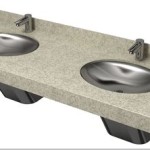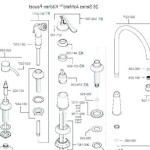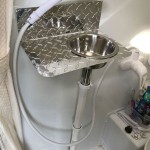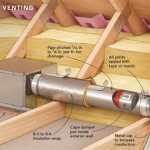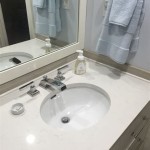How To Fix Bathroom Cabinets Without Sanding
Bathroom cabinets are often subjected to harsh conditions, including high humidity, temperature fluctuations, and frequent water exposure. Over time, these conditions can lead to damage such as peeling paint, scratches, dents, and water stains. While sanding is a common method for preparing surfaces for refinishing, it can be a time-consuming and messy process. Fortunately, there are several effective methods for repairing and refinishing bathroom cabinets without the need for sanding, preserving the integrity of the existing finish while addressing surface imperfections and aesthetic concerns.
Surface Preparation and Cleaning
Proper surface preparation is crucial for any refinishing project, especially when foregoing sanding. The goal is to remove contaminants that could interfere with the adhesion of the new finish. This begins with a thorough cleaning of the cabinet surfaces. Use a degreasing cleaner specifically designed for kitchen and bathroom surfaces. These cleaners are formulated to remove grease, grime, soap scum, and other residues that accumulate over time.
Apply the cleaner to the cabinet surfaces using a soft cloth or sponge. Pay particular attention to areas around handles, knobs, and hinges, as these areas tend to accumulate more grime. After applying the cleaner, wipe the surfaces clean with a damp cloth. Ensure all traces of the cleaner are removed, as any residue can affect the adhesion and appearance of the new finish. It may be necessary to repeat the cleaning process for heavily soiled areas.
After cleaning, inspect the cabinets for any remaining residue or contaminants. If necessary, use a specialized cleaner such as TSP (trisodium phosphate) substitute for stubborn stains or mildew. Always follow the manufacturer's instructions when using any cleaning product, and ensure proper ventilation.
Once the cabinets are clean, allow them to dry completely before proceeding to the next step. A dehumidifier can be used to expedite the drying process in humid environments. A clean, dry surface is essential for a successful refinishing project.
Addressing Minor Imperfections Without Sanding
Bathroom cabinets often exhibit minor imperfections such as small scratches, dents, or chips in the existing finish. These imperfections can be addressed without sanding by using specialized products designed to fill and repair surface damage. One common product is wood filler, which is available in various colors and formulations to match existing wood tones. For painted cabinets, a paintable filler can be used.
To repair a small scratch or chip, apply a small amount of filler to the affected area using a putty knife or a similar tool. Ensure the filler is level with the surrounding surface. Allow the filler to dry completely according to the manufacturer's instructions. Once dry, the filler can be smoothed using a fine-grit sanding sponge or a specialized smoothing tool designed for fillers. The key is to smooth the filler without disturbing the surrounding finish.
For deeper dents or gouges, multiple applications of filler may be necessary. Apply the filler in thin layers, allowing each layer to dry completely before applying the next. This prevents the filler from shrinking or cracking as it dries. After the final layer has dried, carefully smooth the surface to blend it seamlessly with the surrounding area.
Another option for addressing minor imperfections is using a color-matched touch-up paint or marker. These products are designed to conceal scratches and chips in the existing finish. Apply the touch-up paint or marker to the affected area, and allow it to dry completely. If necessary, apply multiple coats to achieve the desired coverage. Blend the edges of the touch-up paint with the surrounding finish using a soft cloth or a blending solution designed for this purpose.
Carefully chosen fillers and touch-up paints can effectively conceal minor imperfections without sanding. This approach preserves the existing finish and avoids the time and mess associated with sanding.
Using Chemical De-Glossers and Bonding Primers
When refinishing bathroom cabinets without sanding, it is essential to create a surface that promotes adhesion of the new finish. Chemical de-glossers and bonding primers are both designed to enhance adhesion without the need for mechanical abrasion. Chemical de-glossers work by etching the surface of the existing finish, creating a slightly rough texture that allows the new finish to grip. Bonding primers, on the other hand, contain adhesive polymers that bond to the existing finish and provide a compatible surface for the new finish.
To use a chemical de-glosser, apply the product to the cabinet surfaces according to the manufacturer's instructions. Typically, the de-glosser is applied using a clean cloth or sponge. Allow the de-glosser to dwell on the surface for the recommended time, and then wipe it clean with a damp cloth. Always wear gloves and eye protection when using chemical de-glossers, as they can be irritating to the skin and eyes.
After using a chemical de-glosser, it is often beneficial to apply a bonding primer. Bonding primers are designed to adhere to a variety of surfaces, including glossy finishes. Apply the primer to the cabinet surfaces using a brush, roller, or sprayer. Ensure the primer is applied evenly and that all surfaces are coated. Allow the primer to dry completely according to the manufacturer's instructions. Some bonding primers may require multiple coats for optimal adhesion.
Alternatively, some all-in-one products combine the properties of a de-glosser and a primer. These products can simplify the refinishing process by eliminating the need for separate de-glossing and priming steps. However, it is important to carefully follow the manufacturer's instructions when using all-in-one products to ensure proper adhesion.
By using chemical de-glossers and bonding primers, it is possible to create a surface that promotes excellent adhesion of the new finish without the need for sanding. This approach preserves the existing finish and minimizes the time and effort required for refinishing.
Application of New Finish and Protective Topcoat
Once the cabinets are cleaned, repaired, and primed as necessary, the application of the new finish can commence. The choice of finish depends on the desired aesthetic and the intended use of the cabinets. Common options include paint, enamel, lacquer, and varnish. For bathroom cabinets, a durable and moisture-resistant finish is essential.
When applying paint, use a high-quality paint designed for kitchen and bathroom cabinets. These paints are typically formulated to resist moisture, mildew, and staining. Apply the paint using a brush, roller, or sprayer. For best results, apply multiple thin coats of paint, allowing each coat to dry completely before applying the next. This prevents runs, drips, and other imperfections.
When using a brush or roller, choose tools that are appropriate for the type of paint being used. For example, use a synthetic brush for water-based paints and a natural bristle brush for oil-based paints. When using a sprayer, thin the paint according to the manufacturer's instructions to ensure proper atomization and a smooth finish.
After the paint has dried completely, consider applying a protective topcoat. A clear topcoat can enhance the durability and moisture resistance of the finish. Common options include polyurethane, lacquer, and varnish. Apply the topcoat using a brush, roller, or sprayer. As with the paint, apply multiple thin coats of topcoat, allowing each coat to dry completely before applying the next.
Ensure proper ventilation during and after the application of the new finish and protective topcoat. This will help the finish to dry properly and prevent the buildup of harmful fumes. Allow the finish to cure completely before using the cabinets. The curing time can vary depending on the type of finish used, so consult the manufacturer's instructions for specific recommendations.
Proper application techniques and high-quality finishes can produce a beautiful and durable result, transforming the look of bathroom cabinets without the need for sanding.
Hardware Replacement and Reinstallation
Replacing or updating the hardware on bathroom cabinets can significantly enhance their appearance and functionality. New knobs, pulls, hinges, and other hardware can transform the look of the cabinets without requiring extensive refinishing. Before replacing the hardware, carefully consider the style and finish that will complement the existing decor and the new finish.
When removing the old hardware, use a screwdriver or other appropriate tool to loosen and remove the screws or fasteners. Carefully store the old hardware in case it is needed for future repairs or replacements. Before installing the new hardware, clean the areas around the screw holes to remove any dirt or debris.
When installing the new hardware, ensure it is properly aligned and securely fastened. Use screws or fasteners that are appropriate for the type of cabinet material. Avoid overtightening the screws, as this can damage the cabinet doors or drawers. If necessary, use shims or spacers to ensure the hardware is properly aligned and level.
For hinges, ensure they are properly aligned and adjusted to allow the cabinet doors to open and close smoothly. If necessary, adjust the hinge screws to fine-tune the door alignment. Consider using self-closing hinges for added convenience and safety.
After the hardware has been installed, inspect it carefully to ensure it is functioning properly. Tighten any loose screws or fasteners, and make any necessary adjustments. Clean the hardware with a soft cloth to remove any fingerprints or smudges.
Replacing and reinstalling new hardware is a straightforward way to revitalize the look of bathroom cabinets without requiring any sanding or refinishing of the cabinet surfaces. The choice of hardware can have a significant impact on the overall aesthetic of the bathroom.

How To Paint Bathroom Cabinets Without Sanding 8 Vital Steps Grace In My Space

How To Paint Bathroom Cabinets Without Sanding 8 Vital Steps Grace In My Space

Diy Gel Stain Cabinets No Heavy Sanding Or Stripping Maison De Pax

7 Easy Steps To Paint Bathroom Cabinets Without Sanding Cottage Living And Style

7 Easy Steps To Paint Bathroom Cabinets Without Sanding Cottage Living And Style

7 Easy Steps To Paint Bathroom Cabinets Without Sanding Cottage Living And Style

Yes Paint Over Stained Wood Without Sanding Porch Daydreamer

How To Paint Bathroom Cabinets Without Sanding 8 Vital Steps Grace In My Space

Prep And Paint Cabinets Without Sanding

How To Refinish A Bathroom Vanity Naturally No Vocs Treasured Tips
Related Posts
